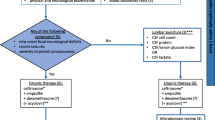Summary
We report a 36-year-old woman with a bacterial meningitis. CT after resuscitation showed a striking “reversal sign.” Opinions on the pathogenesis of this sign are discussed; it indicates serious brain damage and carries a poor prognosis.
Similar content being viewed by others
References
Kim Han B, Towbin RB, De Courten-Myers G, McLaurin RL, Ball WS (1989) Reversal sign on CT: effect of anoxic, ischemic cerebral injury in children. AJNR 10: 1191–1198
Myers RE (1977) Experimental models of perinatal brain damage: relevance to human pathology. In: Gluck L (ed) Intrauterine asphyxia and the developing brain. Yearbook Medical, Chicago, pp 37–97
Kjos BO, Brant-Zawadzki M, Young RG (1983) Early CT findings of global central nervous system hypoperfusion. AJNR 4: 1043–1048
Bird Cr, Drayer BP, Gilles, FH (1989) Pathophysiology of reverse edema in global cerebral ischemia. AJNR 10: 95–98
Author information
Authors and Affiliations
Rights and permissions
About this article
Cite this article
Vergote, G., Vandeperre, H. & de Man, R. The reversal sign. Neuroradiology 34, 215–216 (1992). https://doi.org/10.1007/BF00596339
Received:
Issue Date:
DOI: https://doi.org/10.1007/BF00596339




